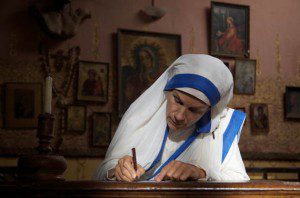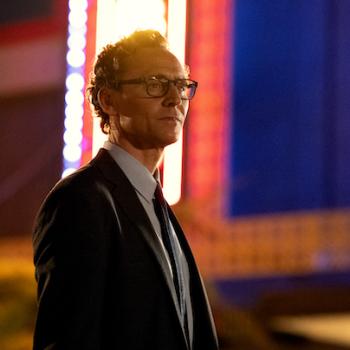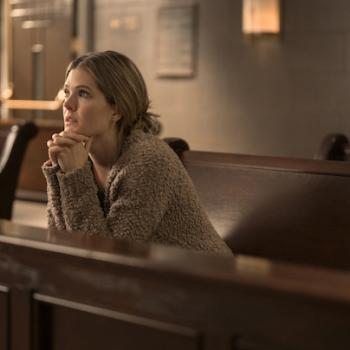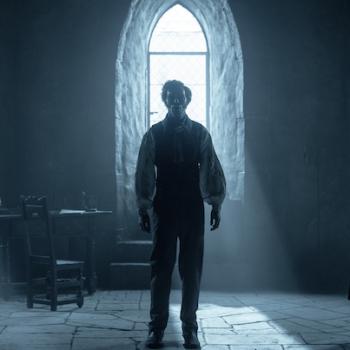
Mother Teresa isn’t a saint. Not yet officially, at any rate. But for many of us, she might as well be. The tiny nun (she was just five feet tall) did some larger-than-life work in the slums of Calcutta, India, serving some of the world’s poorest people through six decades—almost right up until her death in 1997.
But even though I, like most people, knew of Mother Teresa, I didn’t really know that much about her—who she was, how her ministry started, what that calling looked like—before watching The Letters. I never knew she experienced such resistance in her work, even among those that you’d think would be most gratified: Calcutta’s poor and even folks within the Catholic Church itself. The Mother General of the Loreto Convent, The Letters suggests, was particularly reticent about allowing Teresa to work outside the convent’s walls.
But perhaps Teresa’s greatest obstacles were the doubts and darkness in her own soul.

The Letters is a reference to the letters that Teresa (played by Juliet Stevenson) wrote during her ministry to her spiritual friends and advisors—letters that revealed a strange and (some would say) shocking distance from God. The movie gives us insights into the woman through her writing: “This work is far more difficult than I imagined it to be,” she writes in 1948. “Never in all my life did I know that there was so much suffering as I have seen here.” Later, she confesses that “I have been experiencing doubt. Loneliness. The temptation to return to the convent.” Faced with the work that Teresa faced every day, most of us would probably experience doubt, loneliness and the temptation to run away, too. For some reason, we imagined that Teresa—saintly figure that she is—would be immune to such mortal worries. But clearly she was not.
“Inside she was experiencing a terrible emptiness,” says one of her spiritual confidants in the movie, Father Celeste van Exem (played by the incomparable Max von Sydow). “The feeling that she had been abandoned by God.”
Teresa is a fascinating character—and, I imagine, a difficult one to document in a movie. I had the chance to chat a little bit with The Letters Director William Riead (fittingly enough, through email) and learn a bit about who he thinks Mother Teresa was and what drew him to her story.
Asay: Mother Teresa is such a model of Christian sacrifice and charity–really exemplifying what Catholic sainthood, in my understanding, is all about. But what specifically drew you to her story? What makes her such a compelling figure to you?
William Riead: I met Richard Attenborough years ago just after he had finished Gandhi. When I saw the film I thought what an opportunity he had taken advantage of to bring Mahatma Gandhi back to life so the world could benefit from his example. When 9/11 hit it occurred to me that someone should do that again, someone should make a film about a person who would be the polar opposite of that evil, and that would be Anjezë Gonxhe Boiaxhiu—later to become Mother Teresa of Calcutta. My wife and I discussed it and decided I should make that film.
Asay: One of The Letters’ revelations for me was how difficult it was for her to even begin the work she felt so called to do. I had no idea that, once a nun was cloistered, she couldn’t leave the walls of the abbey. Can you explain why there was such resistance inside the Catholic Church—or, at least, inside Teresa’s convent—to Teresa’s apparent calling?
Riead: When a nun becomes a cloistered nun and takes those vows it’s permanent. For a nun to ask permission to leave her Order and go out on her own was something the Church wasn’t accustomed to, especially in those days, and so of course there was resistance. She wrote a letter to the Vatican asking permission to go outside the walls of the Loreto convent to help the poor, and then waited—and I might add patiently without complaint for two years—for the Vatican to get back to her. It took the writings of the BBC reporter Macomb Muggeridge who was constantly rallying to her cause, to get the Vatican’s attention, at which she was finally allowed to leave the walls and begin her work. Other nuns in her Order were not happy about it, especially the Mother General, because they felt she should not have asked to be released from her vows.
Asay: You obviously had a pretty heavyweight cast taking part in this movie—including Max Von Sydow, who was just dubbed by The Atlantic as the “greatest actor alive.” How did you assemble your cast? Were they equally drawn to the story as you were?
Riead: You would have to ask them why they said yes. All I know is I wanted Juliet Stevenson to play Mother Teresa and she graciously said yes, I wanted Max von Sydow to play Father Celeste van Exem and he graciously said yes, and I wanted Rutger Hauer to play the Vatican priest postulator and he too said yes. I’m indebted to them because they were awesome to work with.
Asay: Von Sydow’s appearance in this movie is interesting to me, given how many of his most famous roles had some religious connection to them (Ingmar Bergman’s famed The Seventh Seal, William Friedkin’s The Exorcist, among many others). Is there something that draws him to these spiritual roles, or is there something about his gravitas that just makes him particularly well-suited to play them?
Riead: Again, you would have to ask Max, but he is indeed suited to these types of roles. I absolutely love the guy … he showed up on the set totally prepared, never once went up on a line, was a total pro to work with. Neil Simon once said to me, “When you direct a film make sure you always do three things … get good actors, get good actors and get good actors.” I did exactly that and it made all the difference.
Asay: It’s intimated in The Letters that Teresa’s spiritual “darkness” was an integral part of her work—that without that darkness and spiritual loneliness she wouldn’t be as effective in her ministry. Can you unpack that a bit?
Riead: This is something that only Mother Teresa could speak to and unfortunately she’s not here to do so, but I will say this … in reading her letters, the darkness she experienced seems to have fueled her drive to make life as pleasant as she could for the poor.
Asay: It’s also mentioned that Teresa’s darkness may serve as an inspiration of sorts to those who feel distant from God in their own lives. It seems like, in an age in which the country and Western world are growing more secular, maybe Teresa’s struggles touch a particularly contemporary chord. Would you agree?
Riead: I would definitely agree.
Juliet Stevenson does an expert job of bringing Mother Teresa to life … and in the following exclusive clip, we see that her “letters” weren’t just a one-way street. Here, she receives a letter from the Vatican—and we see the simmering tension between Teresa and the Mother General (played with deft understatement by Mahabanoo Mody-Kotwal).













